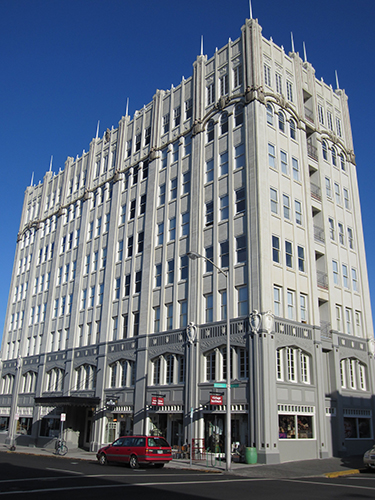|
Subscribe / Renew |
|
|
Contact Us |
|
| ► Subscribe to our Free Weekly Newsletter | |
| home | Welcome, sign in or click here to subscribe. | login |
Real Estate
| |
October 8, 2015
Developer sprucing up Astoria landmark
The Daily Astorian
ASTORIA, Ore. — This summer, local developer Paul Caruana became the sole owner of the John Jacob Astor Hotel, the pre-eminent architectural landmark in downtown Astoria.
The building, mostly used for subsidized housing with businesses on the ground floor, is in the midst of a sprucing up, while Caruana imagines a future mixed-use hotel and apartment building, anchored by a public gathering spot in the former hotel lobby.
Caruana started in spring repainting and waterproofing the building. For the top six floors, he hired Pioneer Waterproofing Co. Inc., whose employees can be seen raising and lowering themselves on scaffolding, slowly painting the building's facade a creamy Navajo white.
Caruana estimated the project is already more than halfway through and will be finished next summer.
“I want it to look like a warm marshmallow sitting on top of a shining emerald,” Caruana said, explaining the dark green paint scheme he hopes to start putting on the base of the Astor Hotel next spring to make the building stand out from the streets and sidewalk.
After the departures last year of Vintage Hardware and Klassy Kloset, the ground floor of the Astor Hotel was largely vacant. But Caruana has since filled all the storefronts. The most recent addition is Doe & Arrow, a men's and women's clothing boutique and vinyl record store opened two months ago.
At the heart of the first floor is the dilapidated, yet still grandiose, lobby of the Astor Hotel, with original porcelain tile, working fireplace, light bulb-ringed John Jacob Astor Hotel sign, crumbling columns and a large staircase leading up to a mezzanine.
Caruana, who said he sometimes lights a fire and hangs out at night, hired an interior designer to turn the lobby into a public gathering place. The rendering includes a lounging area, desks, a coffee bar and a front desk for possible lodging in the hotel.
“Everything from the columns in will be rebuilt,” Caruana said. “It's all an idea right now, but it seems like there's a big need for common space.”
Caruana said he envisions a mix of hotel rooms and apartments, all with access to the lobby. In New York City, he said, there are lots of coffee shops and bars attached to hotel spaces, a feel he would like to bring to Astoria.
Astoria had a good summer, he said, but he wants to see if the upward trend in tourism has staying power before abandoning a working model in his building for something fleeting. He said the process could start in five years and be completed in seven.
After sitting vacant for about 20 years, the Astor Hotel opened in 1984 with 66 one-bedroom and studio units subsidized by the Northwest Oregon Housing Authority. Seven of the units have become market-rate since Caruana and business partner Brian Faherty bought the building in 2008.
When he was buying out Faherty over the summer, Caruana also approached the Astoria City Council for $150,000 in urban renewal funds to help restore the facade. The City Council gave him the money, with the caveat that 50 percent of the apartment units remain low-income.
“It doesn't matter to me where the money comes from,” Caruana said. “I just want good tenants.”
Caruana said the housing authority doesn't have to pay for empty units, adding he has had up to 11 vacant units at a time. Some of the units stayed vacant for up to six months, he added, while he turned away prospective market-rate tenants on a weekly basis.
Caruana and Faherty came before the council in June 2011. They said the low-income housing idea was hemorrhaging money, especially after about $500,000 in water damage from a resident falling asleep with a lit cigarette, sparking a fire and activating the sprinkler system. Caruana said he and Faherty paid more than $100,000 of the damage.
“I want this building to offer housing to whoever needs it,” Caruana said, adding he is still working to improve his residents' quality of life, regardless of how their rent is paid.
Caruana isn't the only person to have grand visions for the Astor Hotel building, which opened as the Hotel Astoria Jan. 1, 1924, the tallest building in Oregon outside of Portland. The restaurant and 150 guest rooms — and 10 apartments on top — were initially a big draw. But the operation became a money pit because of factors such as the construction of U.S. Highway 26, the stoppage of passenger rail service to Astoria and the rising popularity of motels.
The building changed hands several times, experienced a small revival during World War II and was eventually declared off limits by the military. In 1953, the owners painted the building pink and renamed it the John Jacob Astor Hotel, honoring the city's namesake. But by 1968, the building was condemned as a fire and safety hazard.
“This building has been plagued since the beginning,” Caruana said. “I'm hoping not to be another victim of it.”



